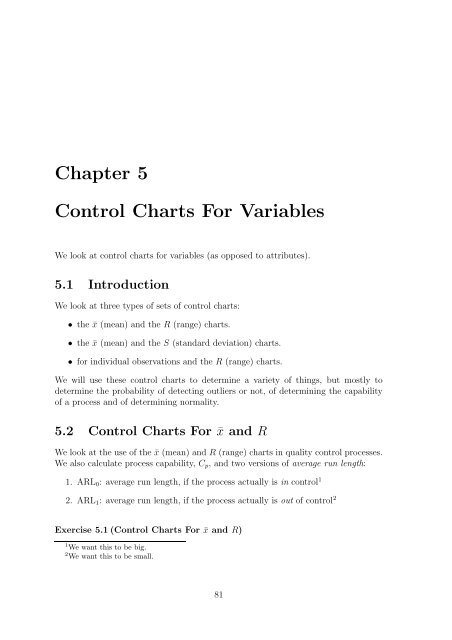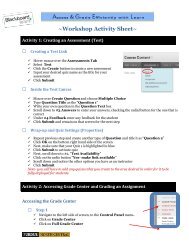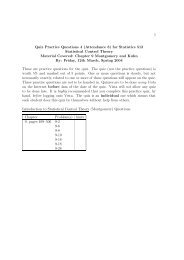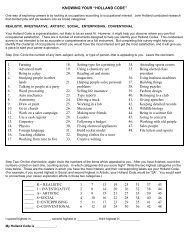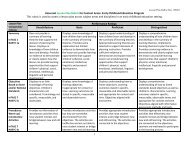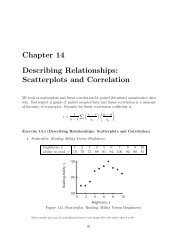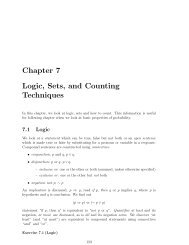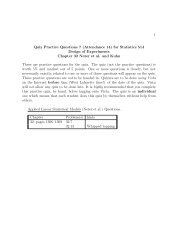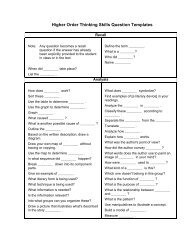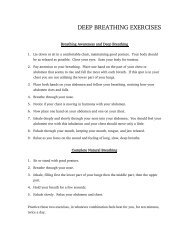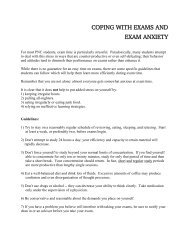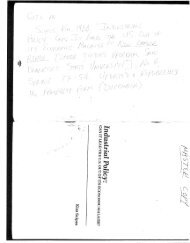Chapter 5 Control Charts For Variables
Chapter 5 Control Charts For Variables
Chapter 5 Control Charts For Variables
- No tags were found...
You also want an ePaper? Increase the reach of your titles
YUMPU automatically turns print PDFs into web optimized ePapers that Google loves.
<strong>Chapter</strong> 5<strong>Control</strong> <strong>Charts</strong> <strong>For</strong> <strong>Variables</strong>We look at control charts for variables (as opposed to attributes).5.1 IntroductionWe look at three types of sets of control charts:• the ¯x (mean) and the R (range) charts.• the ¯x (mean) and the S (standard deviation) charts.• for individual observations and the R (range) charts.We will use these control charts to determine a variety of things, but mostly todetermine the probability of detecting outliers or not, of determining the capabilityof a process and of determining normality.5.2 <strong>Control</strong> <strong>Charts</strong> <strong>For</strong> ¯x and RWe look at the use of the ¯x (mean) and R (range) charts in quality control processes.We also calculate process capability, C p , and two versions of average run length:1. ARL 0 : average run length, if the process actually is in control 12. ARL 1 : average run length, if the process actually is out of control 2Exercise 5.1 (<strong>Control</strong> <strong>Charts</strong> <strong>For</strong> ¯x and R)1 We want this to be big.2 We want this to be small.81
82 <strong>Chapter</strong> 5. <strong>Control</strong> <strong>Charts</strong> <strong>For</strong> <strong>Variables</strong> (ATTENDANCE 4)1. Ice Cream Treat Weight, Raw DataIce cream treats are weighed (in ounces), four at a time (n = 4).sample x 1 x 2 x 3 x 41 7 9 12 142 9 5 5 123 7 10 11 74 8 9 5 145 7 8 11 126 12 11 9 107 16 9 10 78 6 5 11 39 8 7 10 1410 15 17 9 1411 7 12 13 1712 5 11 8 1213 16 10 13 1414 8 13 9 1315 11 8 11 1616 15 11 10 1417 10 9 11 1018 16 8 11 1219 8 7 10 1320 15 17 10 15SAS program: att4-5-2-icecream-xrchart(a) ¯x chart and R chartFrom SAS, both the ¯x chart and R chart for the ice cream weight is (chooseone) in / out of statistical control because there are no out-of-controlsignals, runs, trends, or cycles.(b) (LCL, UCL) for ¯x chart and R chartFrom the SAS graph the average of all averages is,¯x = (choose one) 10.45 / 10.55 / 10.65The upper control limit and the lower control limit for ¯x chart are,(choose one)i. (5.78, 15.32)ii. (5.68, 14.32)iii. (6.78, 15.32)¯x ± 3ˆσ/ √ n = (LCL, UCL) =
Section 2. <strong>Control</strong> <strong>Charts</strong> <strong>For</strong> ¯x and R (ATTENDANCE 4) 83Also, from SAS, ¯R = (choose one) 6.6 / 7.6 / 8.6The upper control limit and the lower control limit for the R chart are,(LCL, UCL) = (choose one)i. (5.5, 14.9)ii. (0, 14.9)iii. (−14.9, 14.9)(c) Natural tolerance limits, control limits and specification limitsUSLupper specification limits(predetermined)UNTLupper natural tolerance limitLCL = 15.32upper control limit10.55LNTLlower natural tolerance limitLSLlower specification limits(predetermined)individual xUCL = 5.78lower control limitaverage x,sample n = 4Figure 5.1 (Natural tolerance limits, control limits and specificationlimits)On the one hand, the control limits for the ¯x chart are,¯x ± 3ˆσ/ √ n = (LCL, UCL) = (5.78, 15.32),whereas, on the other hand, the natural tolerance limits for an individualx are(UNTL, LNTL) = ¯x ± 3ˆσ = 10.55 ± 3(3.18154) =(choose one 3 )i. (1.01, 20.09)ii. (0.68, 24.32)iii. (−1.02, 25.32)and the specification limits are (arbitrarily) predetermined limits set as“goals” to be achieved by the ice cream treat process in this case.(d) More process standard deviationIn addition to reading the process standard deviation ˆσ from SAS, wecould also use d 2 = 2.059 from Appendix VI, page 761 of the text, and sodetermine the process standard deviation to be(choose one) 3.18 / 4.34 / 5.66samplesˆσ = ¯R/d 2 ≈ 6.55/2.059 ≈3 The process standard deviation ˆσ can be found on the SAS printed output.
84 <strong>Chapter</strong> 5. <strong>Control</strong> <strong>Charts</strong> <strong>For</strong> <strong>Variables</strong> (ATTENDANCE 4)(e) Process standard deviation versus standard errorTrue / FalseThe process standard deviation ˆσ = 3.18 does not equal the standarddeviation of the mean, ˆσ¯x = √ ˆσn= 3.18 √4= 1.59(f) Process CapabilityThe process capability, C p , is a statistic used to measure if the naturaltolerance limits (not the control limits!) meet the specification limits ornot. <strong>For</strong> example, if we (arbitrarily) set the specification limits to be(USL, LSL) = (6, 15)and, from above, since we determined the natural tolerance limits to be(UNTL, LNTL) = (1.01, 20.09)then the process capability is, in this case,Ĉ p =USL − LSLUNTL − LNTL=15 − 620.09 − 1.01 =(choose one) 0.47 / 2.12 / 5.66which indicates the “natural” process limits are a well outside the “prescribed”specification limits (which is “bad”); in other words, the processis not able to meet specifications.(g) More process capabilityIf we (arbitrarily) set the specification limits to be(USL, LSL) = (0, 21)the process capability isC p =USL−LSL = 21−0 = (choose one) 0.47 / 1.10 / 5.66UNTL−LNTL 20.09−1.01In other words, the process (choose one) is / is not able to meet specifications.(h) More process capabilityTrue / FalseĈ p =USL − LSLUNTL − LNTL=USL − LSL6ˆσ=USL − LSL6( ¯R/d 2 )≈15 − 66(6.6/2.059)≈ 0.47
Section 2. <strong>Control</strong> <strong>Charts</strong> <strong>For</strong> ¯x and R (ATTENDANCE 4) 85(i) Normal probability plotThe SAS normal probability plot is more or less linear and so indicates theweights of the ice cream treats (choose one) are / are not more or lessnormally distributed.(j) New samples in process control?Five new samples from the ice cream process are plotted on the previouslydetermined control charts above.sample x 1 x 2 x 3 x 41 17 19 22 242 19 14 16 213 16 20 21 174 19 18 15 245 17 18 21 22From SAS, it appears the ice cream process has gone out of control and,more specifically, has shifted (choose one) downwards / upwards althoughthe range of the process still appears to be in control.(k) Probability in control if there is a shift in mean?The probability the process remains in control if the mean shifts from 10.55to 12 ounces, is equal to the probability ¯x falls between the upper controllimit and the lower control limit,P (in control) = P (LCL ≤ ¯x ≤ UCL)= P (5.78 ≤ ¯x ≤ 15.32; µ = 12, ˆσ¯x = 1.59) =(choose one) 0.47 / 0.78 / 0.98Assuming normality, it is 2nd DISTR normalcdf(5.78, 15.32, 12, 1.59)(l) More probability in control if there is a shift in mean?The probability the process remains in control if the mean shifts to 4ounces, is equal to the probability ¯x falls between the upper control limitand the lower control limit,P (in control) = P (LCL ≤ ¯x ≤ UCL)= P (5.78 ≤ ¯x ≤ 15.32; µ = 4, ˆσ¯x = 1.59) =(choose one) 0.13 / 0.68 / 0.87Hint: 2nd DISTR normalcdf(5.78, 15.32, 4, 1.59)(m) Different ways of saying the same thingThe probability the process remains in control if the mean shifts to 4ounces, is another way of saying (choose none, one or more)i. the probability of not detecting a mean shift to 4 ounces.
86 <strong>Chapter</strong> 5. <strong>Control</strong> <strong>Charts</strong> <strong>For</strong> <strong>Variables</strong> (ATTENDANCE 4)ii. the probability of not detecting the first sample average after the shiftout of control, if the mean shifts to 4 ounces.iii. the probability of a type II error, β, or the probability of accidentlyrejecting the alternative hypothesis of a mean shift to 4 ounces.iv. the probability of not detecting the second sample average after theshift out of control, if the mean shifts to 4 ounces.v. the probability of not detecting the third sample average after the shiftout of control, if the mean shifts to 4 ounces.(n) Probability of not detecting first sample average out of controlThe probability not detecting first sample average out of control if themean shifts to 4 ounces isP (5.78 ≤ ¯x ≤ 15.32; µ = 4, ˆσ¯x = 1.59) = (choose one) 0.13 / 0.68 / 0.87(o) Probability of not detecting third sample average out of controlThe probability not detecting third sample average out of control if themean shifts to 4 ounces isP (5.78 ≤ ¯x ≤ 15.32; µ = 4, ˆσ¯x = 1.59) 3 = (0.13) 3 =(choose one) 0.002 / 0.068 / 0.87(p) Probability of detecting mean shiftThe probability of detecting a mean shift to 4 ounces is1 − P (5.78 ≤ ¯x ≤ 15.32; µ = 4, ˆσ¯x = 1.59) =(choose one) 0.13 / 0.68 / 0.872. Ice Cream Treat Weight, Summary Data 4Samples of n = 4 units are taken from an ice cream treat process every hour.After 25 samples have been collected, we find ¯x = 10 ounces and ¯R = 7 ounces.(a) <strong>Control</strong> limitsThe control limits for ¯x are¯x ± A 2 ¯R = 10 ± 0.729(7) =(choose one)i. (4.90, 15.10)ii. (5.68, 14.32)iii. (6.78, 15.32)The (estimated) control limits for R are(choose one)(D 3 ¯R, D4 ¯R) = (0(7), 2.282(7)) =4 Since summary data is given, we cannot use SAS to help us in this question and must useAppendix VI on page 761 of the text.
Section 2. <strong>Control</strong> <strong>Charts</strong> <strong>For</strong> ¯x and R (ATTENDANCE 4) 87i. (0, 15.10)ii. (0, 14.32)iii. (0, 15.98)(b) Process standard deviationThe (estimated) process standard deviation is(choose one) 2.13 / 3.40 / 4.87ˆσ = ¯R/d 2 ≈ 7/2.059 ≈(c) Process capabilityIf the specification limits are (3, 17), the (estimated) process capability isĈ p ===USL − LSL6ˆσUSL − LSL6( ¯R/d 2 )17 − 36(7/2.059) ≈(choose one) 0.13 / 0.40 / 0.69which indicates the “natural” process limits are (choose one) inside /outside the “prescribed” specification limits; the process is not able tomeet specifications.(d) Probability of not detecting mean process shiftThe probability of not detecting a mean process shift from µ = 10 toµ = 14 is equal to the probability ¯x falls between the upper control limitand the lower control limit when µ = 14,P (in control) = P (LCL ≤ ¯x ≤ UCL)= P (4.90 ≤ ¯x ≤ 15.10; µ = 14, ˆσ¯x ≈ 3.40/ √ 4) =(choose one) 0.13 / 0.40 / 0.742nd DISTR normalcdf(4.9, 15.1, 14, 3.4/ √ 4)(e) Review: Average Run Length (ARL)Since µ ≈ ¯x = 10 and ˆσ = 3.4, the probability the process is in control is,P (LCL ≤ ¯x ≤ UCL) = P (4.9 ≤ ¯x ≤ 15.1; µ = 10, ˆσ¯x ≈ 3.40/ √ 4)= 0.99732nd DISTR normalcdf(4.9, 15.1, 10, 3.4/ √ 4)and so the ARL 0 is1ARL 0 =1 − 0.9973 =(choose one) 1.13 / 2.40 / 370.37
88 <strong>Chapter</strong> 5. <strong>Control</strong> <strong>Charts</strong> <strong>For</strong> <strong>Variables</strong> (ATTENDANCE 4)(f) <strong>Control</strong> limits, using α = 0.03 rather than σIf α = 0.03, the control limits for ¯x are(choose one)i. (4.90, 15.10)ii. (5.68, 14.32)iii. (6.31, 13.69)¯x ± z 0.03/2ˆσ¯x = 10 ± 2.17Hint: z 0.03/2 = 2.17, using invNorm(0.985)( ) 3.4√45.3 <strong>Control</strong> <strong>Charts</strong> <strong>For</strong> ¯x and SIn this section, we look at control charts 5 for ¯x and SExercise 5.2 (<strong>Control</strong> <strong>Charts</strong> <strong>For</strong> ¯x and S: Ice Cream Treat Weight)Ice cream treats are weighed (in ounces), four at a time (n = 4).sample x 1 x 2 x 3 x 41 7 9 12 142 9 5 5 123 7 10 11 74 8 9 5 145 7 8 11 126 12 11 9 107 16 9 10 78 6 5 11 39 8 7 10 1410 15 17 9 1411 7 12 13 1712 5 11 8 1213 16 10 13 1414 8 13 9 1315 11 8 11 1616 15 11 10 1417 10 9 11 1018 16 8 11 1219 8 7 10 1320 15 17 10 155 Notice, we are looking at a control chart for S, for standard deviation, and not R, for range, asit was done previously.
Section 3. <strong>Control</strong> <strong>Charts</strong> <strong>For</strong> ¯x and S (ATTENDANCE 4) 89SAS program: att4-5-3-icecream-xschart1. ¯x chart and S chartFrom SAS, both the ¯x chart and S chart for the ice cream weight is (chooseone) in / out of statistical control because there are no out-of-control signals,runs, trends, or cycles.2. (LCL, UCL) for ¯x chart and S chartFrom the SAS graph, ¯x = (choose one) 10.45 / 10.55 / 10.65The upper control limit and the lower control limit for ¯x chart are,(choose one)(a) (5.78, 15.32)(b) (5.86, 15.24)(c) (6.78, 15.32)¯x ± 3ˆσ/ √ n = (LCL, UCL) =From SAS, ¯S = (choose one) 2.9 / 7.6 / 8.6The upper control limit and the lower control limit for the S chart are,(LCL, UCL) = (choose one)(a) (5.5, 14.9)(b) (0, 14.9)(c) (0, 6.5)3. More (LCL, UCL)The control limits for the ¯x chart and S charts,(LCL, UCL) = (5.86, 15.24)is (choose one) the same as / different fromthe control limits for the ¯x chart and R charts,(LCL, UCL) = (5.78, 15.32)because the process standard deviation, ˆσ is calculated differently in the twocases.4. Process standard deviationIn addition to reading the process standard deviation ˆσ from SAS, we couldalso use c 4 = 0.913 from Appendix VI, page 761 of the text, and so determinethe process standard deviation to be(choose one) 3.15 / 4.34 / 5.66ˆσ = ¯S/c 4 ≈ 2.9/0.9213 ≈
90 <strong>Chapter</strong> 5. <strong>Control</strong> <strong>Charts</strong> <strong>For</strong> <strong>Variables</strong> (ATTENDANCE 4)5. Process capabilityIf we (arbitrarily) set the specification limits to be(USL, LSL) = (0, 21)and since the natural tolerance limits for an individual x are(UNTL, LNTL) = ¯x ± 3ˆσ = 10.55 ± 3(3.12691) = (1.169, 19.931)the process capability isC p =USL−LSL = 21−0= (choose one) 0.47 / 1.12 / 5.66UNTL−LNTL 19.931−1.169In other words, the process (choose one) is / is not able to meet specifications.6. More process capabilityTrue / FalseĈ p =USL − LSLUNTL − LNTL=USL − LSL6ˆσ=USL − LSL6( ¯S/c 4 )≈21 − 06(2.9/0.9213)≈ 1.117. Probability in control if there is a shift in mean?The probability the process remains in control if the mean shifts from 10.55 to17 ounces, is equal to the probability ¯x falls between the upper control limitand the lower control limit,P (in control) = P (LCL ≤ ¯x ≤ UCL)= P (5.86 ≤ ¯x ≤ 15.24; µ = 17, ˆσ¯x ≈ 3.12691/ √ 4) =(choose one) 0.13 / 0.78 / 0.98Assuming normality, it is 2nd DISTR normalcdf(5.86, 15.24, 17, 1.56)8. Probability of not detecting first sample average out of controlThe probability not detecting first sample average out of control if the meanshifts from 10.55 to 17 ounces isP (5.86 ≤ ¯x ≤ 15.24; µ = 17, ˆσ¯x = 1.56) = (choose one) 0.13 / 0.68 / 0.87
Section 4. The Shewhart <strong>Control</strong> Chart <strong>For</strong> Individual Measurements (ATTENDANCE 4)915.4 The Shewhart <strong>Control</strong> Chart <strong>For</strong> IndividualMeasurementsIn this section, we look at Shewhart control charts for individual measurements.Exercise 5.3 (Shewhart control charts for individual measurements)Thirty (30) individual ice cream treats are weighed (in ounces).SAS program: att4-5-4-icecream-irchart5.4 8.6 9.5 4.0 0.9 5.2 5.52.8 5.3 6.3 3.9 9.8 6.9 9.85.1 8.4 1.0 1.2 7.1 5.7 0.61.0 3.0 6.0 7.2 8.0 5.9 0.07.9 3.41. Individual measurement chart and moving range MR chartFrom SAS, both the individual chart and moving range MR chart for the icecream weight is (choose one) in / out of statistical control because there areno out-of-control signals, runs, trends, or cycles.2. Moving range, MR iSince the weight of the first ice cream treat is x 0 = 5.4 and the weight of thesecond ice cream treat is x 1 = 8.6, the first moving range (based on n = 2observations) isMR 1 = |x 1 − x 0 | = |8.6 − 5.4| = 3.2and so the second moving range isMR 2 = |x 2 − x 1 | = |9.5 − 8.6| =(choose one) 0.5 / 0.9 / 1.6The average of all moving ranges is denoted MR.3. (LCL, UCL) for individual measurement chartFrom the SAS graph, ¯x = (choose one) 5.2 / 10.5 / 10.6The upper control limit and the lower control limit for the individual measurementchart are,(choose one)¯x ± 3ˆσ = ¯x ± 3 ¯R/d 2= ¯x ± 3MR/d 2= 5.2 ± 3(3.22069/1.128)= (LCL, UCL) =
92 <strong>Chapter</strong> 5. <strong>Control</strong> <strong>Charts</strong> <strong>For</strong> <strong>Variables</strong> (ATTENDANCE 4)(a) (−5.4, 11.7)(b) (−3.4, 13.7)(c) (−1.4, 15.7)4. (LCL, UCL) for moving range chartFrom the SAS graph, ¯R = (choose one) 3.22 / 5.52 / 10.6The upper control limit and the lower control limit for the moving range chartare, (choose one)(a) (0, 10.52)(b) (0, 11.72)(c) (0, 15.75)5. Difficulty with moving range chartsTrue / FalseSince the moving range chart is calculated using two consecutive observationsin the individual measurements chart, the two charts are highly dependent onone another. <strong>For</strong> example, a sharp increase between two values in the individualchart will cause a sharp increase in the range chart. This dependence betweencharts worries some analysts enough to not use the moving range chart.5.5 Summary of Procedures <strong>For</strong> ¯x, R and S <strong>Charts</strong>This is covered in the previous three sections.5.6 Applications of <strong>Variables</strong> <strong>Control</strong> <strong>Charts</strong>There a number of interesting examples given in this section.


